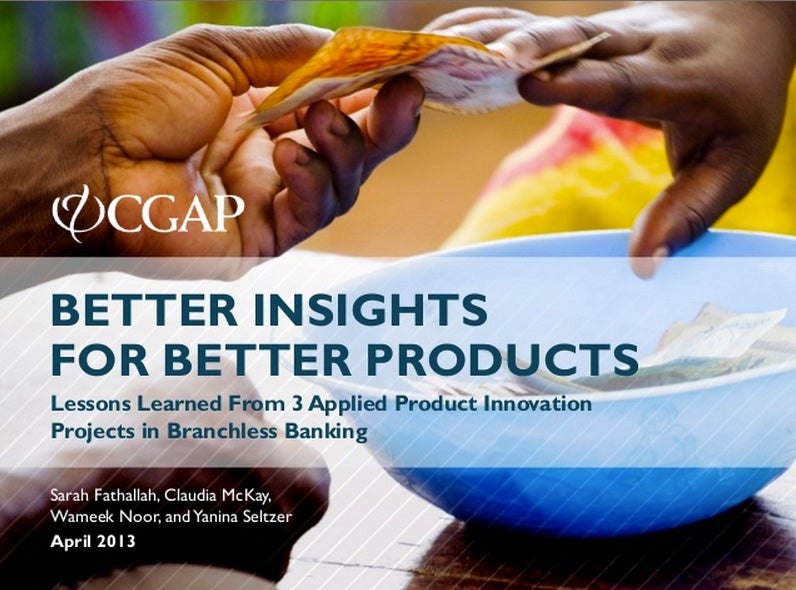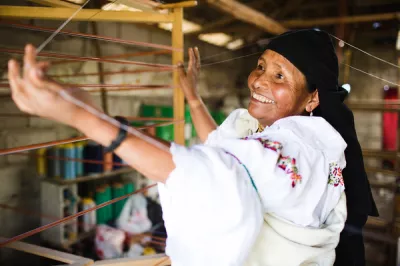Getting Better Insights To Design Better Financial Products
Do these look familiar to you?
c = 2.997 x 108m / s
F= Gm1m2/r2
6CO2+ 6H2O + C6H12O6+ 6O2
If you got through high school physics and biology without falling asleep, the answer is probably yes. Now, without searching for these on Google, do you know what these equations stand for? For some who are science geeks, you probably figured out a couple of these… but for the rest of us, these equations are at most vaguely familiar. Similarly, concepts like compound interest rate and insurance premiums are very familiar to those of us in the financial world but seem like a different language to most of our customers. Communicating an offering or product in a ‘foreign’ language is counterproductive. It’s important for providers to know that communication is a key piece of an offering and that speaking people speak instead of finance speak is essential when talking to our customers.
 A lady stands in the field with her cattle.
A lady stands in the field with her cattle.
This is just of one of many lessons we learned from our three Applied Product Innovation (API) projects which have taken place over the past 18 months in Brazil, Mexico and Uganda. Today, CGAP is releasing a synthesis deck which highlights our experiences in product innovation and helps providers understand how they can use customer-centric approaches to improve their offerings.
We all know that most branchless banking services struggle with low activity rates. 172 branchless banking implementations have been launched since 2007, but CGAP estimates that less than 20 of those have reached 200,000 active users. Providers are tackling this in a number of ways, like launching huge promotions and raising agent commissions. Ultimately potential customers need to believe that product offerings meet their unique needs and this just doesn’t seem to be happening in most places. Despite thousands of surveys, most providers struggle to understand what their low-income and under banked customers need and how they should articulate the value proposition.
Our work in API aims to understand how customer-centric design methodologies (inspired by the human-centered design approach) can be tailored to branchless banking in order to achieve better financial service offerings for the poor. We know that understanding customers and translating customer insights into products has worked in a variety of other industries such as consumer goods and technology. In financial services, there are some examples of companies that applied customer insights to create new products with a focus on the user experience, a rapid feedback loop, and appropriate pricing. Could this approach help branchless banking providers better understand customers and how to design products that would actively be used by them?
We carried out our three API projects with a variety of partners including large-scale commercial banks and MNOs along with expert and specialized design firms. We distilled a huge amount of lessons and tools from these projects (take a look at our deck for more info). Here are some of the key messages for providers:
- Thinking like a designer gives you a new lens with which to look at your customers and product offerings.
- Connect with your customers! Don’t outsource this critical task to your marketing team or an external firm. Talk to your clients. Ask them questions about your product, but also ask them about their lives. Observe their surroundings and home. This will give you huge insights on who you are serving which will improve your offerings. There are a number of fun and useful tools to facilitate conversations on tricky subjects like finances with your clients (for more information, go here)
- Sometimes talking to a dozen people for a couple of hours can give you more insights than talking to thousands of people for 10 minutes. You can draw patterns from these conversations and you can encourage creativity internally to come up with new ideas to better serve your customers. (For more information, go here)
- Prototyping can be simple and inexpensive and allows you to quickly test product concepts with customers and reject or amend these concepts as needed. In fact, prototypes can be as simple as a storyboard or a cell phone screen print-out explaining a simple concept. Going out and talking to clients about these ideas can be easy, inexpensive, fun and enlightening. (For more information, go here)
- It is ultimately not all about a killer product. The entire user experience must reflect customers’ needs and desires and is just as important as the product itself. Things like marketing messages, the user interface and even basic network uptime are as essential to implement well, as much as a great product. Without the right ecosystem in place, even the most innovative of products can fail.
- Hiring a design firm is ideal as you’ll get experienced people who have gone through the process of customer insights to product design hundreds of times. However, there are a number of design elements that providers can try and use on their own.
There is no ‘right’ equation to arrive at a well-designed product. But ensuring customers feel comfortable during conversations about financial services, listening to their needs and wants, communicating in people speak, encouraging innovative ideas and frequently testing concepts and seeking feedback from customers are certainly key components. The crucial ingredient: remembering that customers are always at the center.
Claudia and Yanina will be taking your questions on the design process in a live web chat with Patrice Martin of IDEO.org on 18 April. Send us your questions and comments.
P.S. For those who are still wondering: the first equation is the speed of light, the second the force of gravity and the third the chemical process for photosynthesis.
---- The authors work on applied product innovation in the Technology and Business Model Innovation Team at CGAP.





Comments
Dear Claudia and Yanina
Dear Claudia and Yanina
I would like to share a few points with better insights on the complexity of iteration of experimented ideation globally.
First, the need for better insights for designing better human centered products has been realized thanks to branch less mobile mode , and were experimented in three selected countries. Although this ideation is useful innovation , it appears confining to one segment of population that is ‘low income small entrepreneurs only for convenient form of transferring financial services facilitating the provider thro branch less mode. The success of prototype as reported is of any indication, it is better for limited customers of one segment that too with just transfer services only. In the context of wider persistence of poverty and elusive MDG in qualitative terms in the global arena, iteration of above ideation for the benefit of various segments of low income categories in rich countries and the marginalized poor with varying level of vulnerability and deprivation in developing countries, has limited values . It is mainly because the use of the term ‘ poor’ remains ambiguously overlapping extreme poor with moderate one in the poverty spectrum . For better challenging this issue with different approaches with clarity in the target group in poverty segment, it is suggested at advocacy/policy level that the WB’s Consultative Group to Assist the Poor that works toward a world in which everyone has access to the financial services they need to improve their live, could have two separate wings as follows
a) Consultative Group to assist Low income customer ( CGALic) with the focus on only assisting financial access to them in western and European countries through branch less mode
b) Consultative Group to assist the poorest (CGAP) with the focus on assisting micro financial access in rest of the countries through both branch and branch less modes.
c) While CGALic need ethnographists among the consultants , CGAP need development ethicist socio anthropologist and indigenous microfinance consultant among the group members for grasping best insights and design best products with human face
Second, for designing client oriented better product and ensuring equitable distribution of its benefit in the poverty segment irrespective of mode of delivery, it demands first clarity on the target group for whom the product is being designed . Perhaps this is the first step for better perceiving in sights the particular human being centered for product designing. That is to say whether it is for low income customer , low earning clients, vulnerable poor, marginalized poor, ultra poor, the poorest, transient poor, poor, rural clients, unbanked/under banked (of late) as each one has exclusivity in their characters contextually demanding assistance not only for accessibility to diversified financial services but also other services for sustain the productivity of such services assisted. Further the low income customer in western country parlance cannot be the counterpart to the vulnerable poor in Asia and African countries. While the former is a ready made customer for any mode of the financial services , the latter kind is to be nurtured to graduate them as client with a sequenced diversified financial services prudently by branch mode with face to face human relationship. Once the clarity is made to identify the client , then only best insights of the respective clients needs is discernible for designing such client centered products for either branch or branch les modes or both
Third in the case of credit product appropriateness , in the case of low income group in rich countries, is related to clients acceptance, and technological feasibility while in the case of vulnerable poor other countries , the product feasibility is more influenced by a) capability of the poor b) the potential of product (IG activity) in the given market (without saturation) c) extent of presence of supporting inputs for productive credit absorption
In fine, applied product innovation need to start from the bottom clients towards their graduation not necessarily confining to branch less mode for the benefit of the various actors in supply chain and a single segment of population there by widening inequality gap
Thanks for sharing my views
Dr Rengarajan
First of all I have missed
First of all I have missed the web chat, but would like to be connected on this topic. FIs mostly have been designing products like one size fits all, either you take it or leave it. The paradigm shift, if I may call it could be where we can listen to each of our customer and provide a tailor made product to suit the needs. If these two can be termed as the two extremes of the rainbow, then any thing in between can be attractive for many.
The main hurdle is the research that needs to be forming the base of any designing for such products. Normally such work is assigned to the Marketing units in the banks, and they further go ahead to design the products.
I am in need of getting linked to such discussions threads where people are sharing their feedbacks on designing the products ( maybe I will get some in LinkedIn).
Any suggestions, views are welcome.
Add new comment